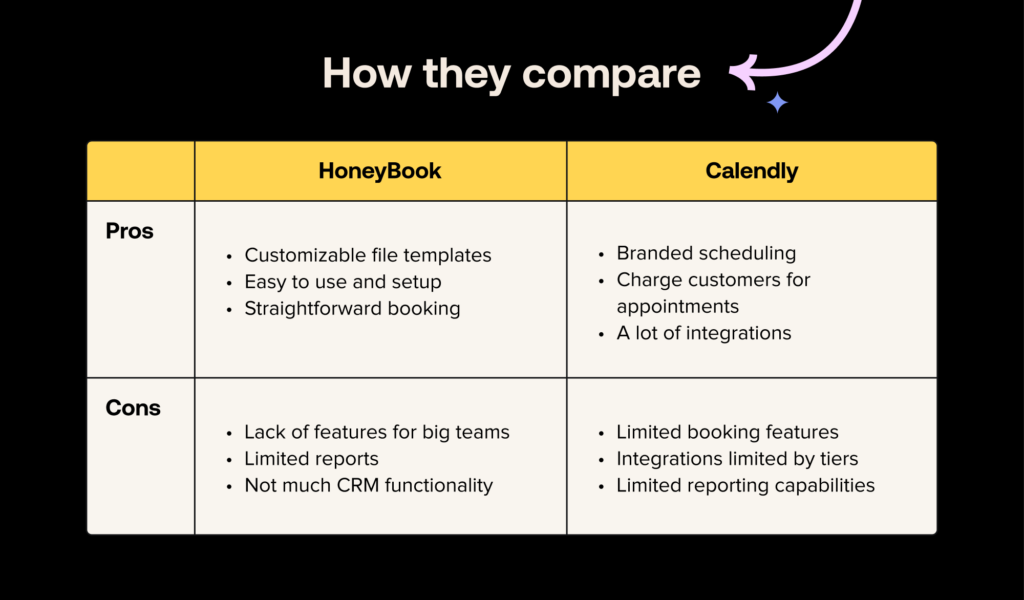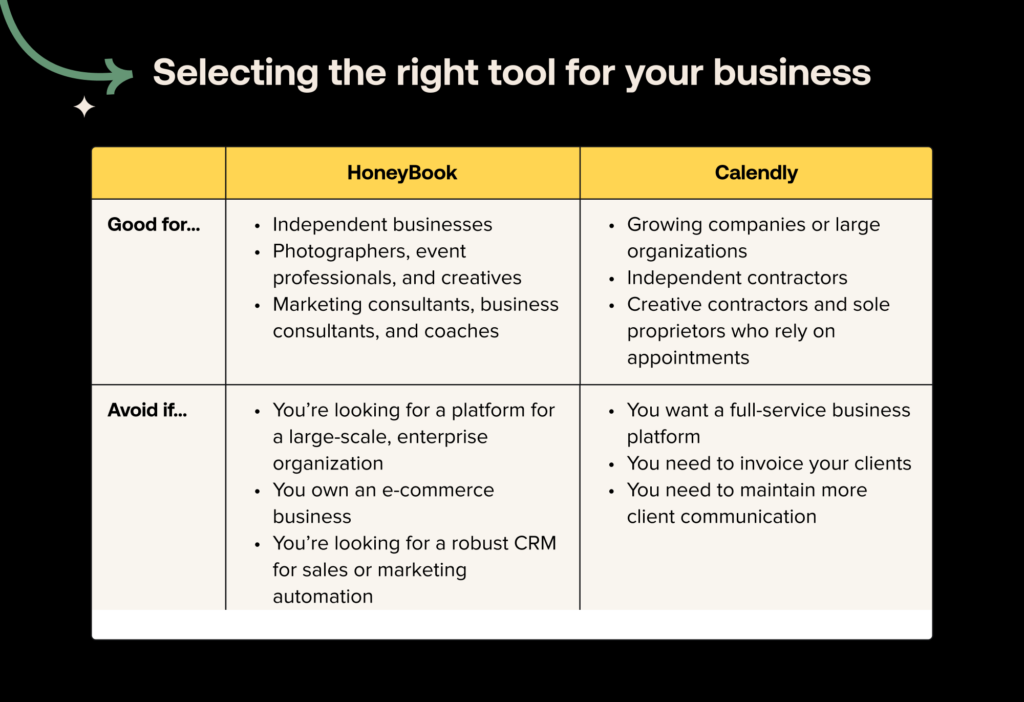Though Calendly is one of the top platforms for online scheduling, HoneyBook is a solid contender. See how both compare and which one is best for your business.
Scheduling meetings is crucial for many business types. Though it seems like such a simple part of your day, it’s how you speak with new clients, conduct sales calls, and move your client work forward. That’s why the right scheduling tool can make a big difference in your workflow. It can make it easier for new leads to find you and create a more professional client experience.
We all know that Calendly is one of the most used and well-known scheduling tools out there, but we wanted to compare it against HoneyBook. We know that the users looking into Calendly might only need scheduling, but we wanted to evaluate both platforms based on the other features they have to offer as well, like lead management, booking, and client communication. The good news is that Calendly integrates with HoneyBook, so if you’re torn which to choose, they actually work great together.


Jump to:
- Scheduling
- Lead management
- Invoicing
- Contracts
- Payments
- Client communication
- Reporting
- Mobile app
- Integrations
- Customer support
- Pricing
- Summary
Scheduling
Who wins out?
Calendly is one of the most-used scheduling tools for a reason. Though HoneyBook offers a lot of the same features, Calendly overall offers a bit more customization with how you can schedule appointments. HoneyBook overall offers more business management features, which we’ll cover below, and you can even integrate Calendly into HoneyBook, meaning you don’t necessarily have to pick one.
HoneyBook
Inside your account, you can sync your Google, Microsoft, and Apple calendar. Once you integrate, you can see all of your meetings and appointments in one place, plus add team members to view their schedules in your calendar view as well.
With your calendar synced, you can present an accurate view of your availability within the HoneyBook scheduler. Just like other tools like Calendly, you can build specific session types, set your availability for each one, and send them to leads or clients with a link to book time with you. If you prefer Calendly, you can even integrate with HoneyBook to have all of your Calendly meetings show up on your HoneyBook calendar.
Instead of going back and forth to find a time that works, clients can select an open time slot on your calendar. Unfortunately, I found it a bit limiting since you can’t offer group scheduling or rescheduling for clients on HoneyBook.
If you also require clients to pay before scheduling with you (say you’re a photographer or a consultant), you can do so with a lead form or a scheduling file template that includes invoice and payment.
Calendly
Scheduling is where Calendly shines. In fact, poor scheduling tools seem to be the problem that the Calendly app was designed to solve. Here are a few things I enjoyed about using Calendly for scheduling:
- Connect your Google, Microsoft, and Apple calendars.
- You can customize your Calendly calendar and scheduling page to match your company’s colors, fonts, and more.
- Set up your scheduler in a matter of minutes with the ability to create four different session types: one-on-one, group, collective, and round-robin.
- If you upgrade from the free service to the Standard service, you’ll be able to integrate Stripe and PayPal to accept payments as soon as a prospect schedules your time. This comes in handy in terms of ensuring that you’re paid for your time, even if your customer misses their appointment.
- You can take advantage of other calendar integrations. So when someone schedules a meeting on your Calendly calendar, you’ll see it across any other calendars you’ve set up for your business and yourself. I found that this really cut down on the problem of overbooking myself or having to flip between calendars to ensure that I wasn’t overbooking.
- Take advantage of Workflows to automate reminders, thank yous, and feedback requests.
- Use Routing to qualify leads and direct them to a specific session type.
- Finally, Calendly captures all the information you should need on your clients when they schedule appointments with you and stores them in your contacts for future use.
Lead management
Who wins out?
If you capture and qualify your leads using meetings, Calendly has some great options for capturing them in the right places and routing them properly. However, HoneyBook offers more comprehensive features, like lead capture forms, automated communication, and even AI lead qualification.
HoneyBook
HoneyBook offers two options for capturing leads: a standard contact form and a more robust lead form. Both are customizable, but the HoneyBook contact form is a simple way to capture leads, while lead forms enable you to add additional actions, like scheduling a meeting and paying up front.
You can share both forms on your public channels or privately to capture interested leads. I especially like the fact that you can choose from templates or build from scratch and save multiple forms for different audiences.
Once leads inquire, HoneyBook captures them and adds them to your account and project pipeline. I’ve customized my pipeline to match the steps I use to move leads forward to booking, which makes lead management easier. Plus, I like that you can manage all your communication and files in one project workspace with leads and clients.
Another great feature is HoneyBook automations, which I’ve used to set up instant responses and guide leads through next steps, such as filing out a questionnaire, scheduling time, and booking.
HoneyBook does have it’s limitations with lead management. It doesn’t operate as a traditional CRM where you can score leads or nurture them and access other sales features like marketing automation. In my use, I think its lead management is great for independent businesses that don’t have a large volume of leads.
Calendly
Lead management is an integral part of any business, and Calendly does offer some useful lead management tools. For example, if you sign up for the company’s “Teams” service, you’ll be able to take advantage of features like:
- Lead routing: With lead routing, you can build a form and route potential customers to different pages depending on the answers to those questions. I found this feature to be incredibly useful for qualifying potential leads and routing those who would likely be a waste of time to other options.
- Links: I used my Calendly links in any calls to action in sales emails or blog posts for a while, and that seemed to work well. When prospective clients clicked those links, they were able to quickly schedule appointments to learn more about the services I offer.
- Automation workflows: While Calendly’s automation tools aren’t what I would call robust, its automation workflows do help with lead management. In particular, you can set automated reminders via email or text message to help ensure that your clients don’t miss their appointments.
While these tools are useful, they don’t address the entire lead management process. When it comes to finding leads and information, staying in contact, and ultimately making the sale, you’ll need to take advantage of integrations or use another tool altogether. That being said, the tools above did prove to be effective in helping me qualify and close leads.
Invoicing
Who wins out?
Calendly lets you accept payments for appointments, but it doesn’t offer any invoicing. If your business relies on more long-term projects where an invoice is necessary, HoneyBook wins out with its robust gallery of invoice templates and customizations.
HoneyBook
As soon as you create a HoneyBook account, you have access to invoice templates that are easy to customize and use–whether you need a general invoice or a version that’s built specifically for your company type.
Like HoneyBook’s other templates, you can edit your invoice templates or build from scratch using a drag-and-drop editor that supports text, video, and images. I was able to easily incorporate my company brand to make sure my invoices were personalized.
The best part about HoneyBook invoices is the ability to include other actions, like service selection, contract signing, file upload, questionnaires, and scheduling. With every invoice, HoneyBook includes integrated payment processing, so your clients don’t have to jump into another service to pay.
For instance, I can use an all-in-one booking file that includes my meeting scheduler, an invoice for the session, a contract, and payment processing.
Calendly
Because Calendly made it simple to charge potential customers a retainer when they scheduled appointments, I was shocked to find that there were no invoicing features to speak of. I would think that with a service like this, it would be advantageous to be able to create custom invoices for clients. But that option wasn’t available without integrations.
The good news is that Calendly offers a robust list of integrations, and you can use an invoicing program, or even a payments platform like PayPal, to build and send invoices. But I’m still somewhat confused as to why Calendly didn’t invest the time and money into offering this feature on its own.
Contracts
Who wins out?
HoneyBook offers a variety of contracts for different industries, while Calendly does not. If you want clients to sign agreements with you before booking a meeting (say a paid consultation, for example), HoneyBook definitely wins out.
HoneyBook
HoneyBook offers attorney-reviewed contract templates that you can immediately update with your own information and start using with clients. Whether you need a general contract or a specific agreement (liability waiver, proof sign-off, model release, NDA, etc.), HoneyBook has several options to choose from.
As always, I was still able to start from scratch and drop in my own specific legalese that I wanted to use, but the templates are a really great start.
The contract templates include smart fields, which allowed me to dynamically populate client and project information, like client name, project name, and project date. I saw that you can also pull in information that you’ve set for your company, such as payment late fees and your company information.
I love that HoneyBook contract templates are accessible via desktop or mobile, allowing your clients to eSign from any device.
Calendly
Calendly doesn’t offer a feature that makes it possible to build custom contracts. This was another surprise, as it would be nice to be able to create a contract that potential clients sign when they schedule appointments. Again, I’m sure that with Calendly’s robust integration opportunities, you could bring in a third-party tool to help with this. But it would be far better if Calendly were an all-inclusive tool that made this feature available from the start.
Payments
Who wins out?
Both options offer payment processing for scheduling appointments and sessions, but HoneyBook offers payments already integrated through the platform with low fees. With Calendly, you have to set up your own integration through PayPal or Stripe, and this is an added cost on top of payment processing fees.
HoneyBook
With integrated payment processing in your invoice templates, HoneyBook makes it faster for you to get paid. In fact, 90% of HoneyBook invoices get paid on time.
Through HoneyBook, I accept credit card and ACH payments and enjoy some of the lowest transaction fees in the industry, starting at 2.9% + 25¢ for cardholder-entered payments. For reference, PayPal’s cardholder entered fees start at 2.99% + 49¢.
While the integrated payments are helpful for me, I could see that some may not like the inability to choose their own payment processor.
One thing I really love about HoneyBook is that you don’t have to chase payments. You can turn on automatic payment reminders and autopay, along with late payment fees for clients who pay past their due dates.
For greater organization, HoneyBook also enables you to track payment statuses in one place. Plus, view your profit and loss and get greater accounting insights with a seamless integration to Quickbooks.
Calendly
I have mixed feelings when it comes to payments with Calendly. As mentioned above, it was nice to be able to charge a retainer fee as soon as a potential customer scheduled an appointment to chat. Unfortunately, that’s where my delight with Calendly’s payments stopped.
Calendly proclaims that you’re able to accept credit card and PayPal payments. What the platform doesn’t tell you until you sign up is that you’re able to accept these payments only through integrations. You can integrate PayPal, Stripe, or both.
Of course, when you take advantage of both, you’ll be able to accept payments via PayPal, credit card, debit card, and online check, but having to do so through integrations only convolutes the process. It would be better if Calendly were to offer its own payment gateway that you could use instead of relying on integrations.
It’s also worth mentioning that payment integrations aren’t available on the free service. You’ll have to at least opt for the “Standard” service at $10 per seat per month to incorporate payments into your calendar.
Client communication
Who wins out?
HoneyBook wins out in client communication. You can schedule with leads and automatically save them as a contact, then store all your communications with them in one place and leverage automated emails as well. While you can use Calendly to communicate with clients through text and email about appointments, it doesn’t offer options for more long-term communication. That’s where you would need to integrate with another CRM to move your Calendly contacts over and continue fostering relationships.
HoneyBook
With HoneyBook, I don’t have to worry about sifting through emails or missing client communication. You can integrate any email provider with your account so you’re able to see client emails inside your workspaces. The only downside is that you have to start an email thread in your HoneyBook account, so it won’t pull in all of your emails in your inbox.
From there, you can leverage HoneyBook email templates to save time, set up automated emails at key moments (like after a lead inquires), and even use HoneyBook’s AI Composer to quickly send messages to leads and clients that fit your tone and voice. I personally love setting up email automations for my inquiries to make sure I respond quickly and save time providing information to them.
Though I didn’t set one up, you also have the opportunity to create a branded client portal that clients can use to view communications and files in one place.
Calendly
Client communication was one of the areas in which I felt as though Calendly fell short. I would have loved to see an inbox on my dashboard or a feature that allowed me to chat with my clients without having to go outside of the application. But those features are nonexistent.
The good news is that Calendly does come with some tools for communicating with your customers. In particular, you can set up automated email and text reminders to remind your customers about the appointments they set with you. On the other hand, automations are typically set across the board. That means you won’t be able to send unique messages to any individual client through this system.
Reporting
Who wins out?
While Calendly offers reports based on how many appointments you schedule and how many people view your session pages, HoneyBook offers more robust business reports. You can view your booking rate, collected and outstanding payments, and learn more about your most popular lead sources.
HoneyBook
HoneyBook offers several reports to provide insights on things like:
- Monthly bookings
- Booking rate
- Collected payments
- Outstanding payments
- Refunded payments
- Lead sources
Though you can select a specific time frame to view each report, it is a bit limiting that you can’t customize any of the reports.
Premium HoneyBook users can also access team member and client reports.
Calendly
I was initially pleasantly surprised with Calendly’s reporting capabilities. However, that first impression was misleading.
At first glance, Calendly reports looked great. You can get a complete picture of how many appointments are being set, how many people visit your calendar, and what each member of a seat you pay for on the app is doing.
So where did Calendly fall short of my expectations?
Unfortunately, the platform saves data for only one year. That was a real pain point for me because I enjoy comparing data. One of the biggest comparisons I make with my business is how data from right now compares to data from one year ago, as well as from previous years. Unfortunately, these comparisons are impossible without historical data.
Mobile app
Who wins out?
Calendly is known for its easy-to-use mobile app, which is comparable to its desktop site. On the other hand, HoneyBook’s mobile app acts more like a companion to the mobile site, though it does offer more features than Calendly.
HoneyBook
Within the HoneyBook mobile app, you can view your project pipeline to see statuses at a glance, plus view and edit your task list. You’re also able to manage your calendar and share your scheduler link along with other client communication, like sending and editing files.
Though you can customize your notifications, you have the option to get notified when you have a new message, when a client views a file, when someone signs a contract or pays an invoice, and when you have a task coming up.
Another great feature of the mobile app is time tracking. If you price your services by the hour, the time tracker enables you to stay on top of your working hours, then easily create an invoice directly from your tracked time.
Though the app is robust, I find it to be more of a companion to the desktop site since it doesn’t offer all of the same capabilities.
Calendly
Calendly’s mobile app was an area that really impressed me. Most of the time, when I take advantage of business management tools, I find that the mobile apps are only limited versions of what the desktop applications provide.
That wasn’t the case with Calendly.
I found Calendly’s mobile app to be just as robust as its online platform. Some features seemed to be even more user-friendly when I took advantage of them using the mobile app than when I used them on the desktop.
Integrations
Who wins out?
If scheduling is most important to you and you’re comfortable with using a variety of other platforms for your business needs, Calendly is a great solution for integrations. It offers a ton of integrations so you can keep all your scheduling in Calendly, but import your contacts and their data elsewhere. In fact, it also integrates with HoneyBook.
HoneyBook
HoneyBook offers the following integrations:
- Email and calendar (multiple platforms): Integrate your Gmail, Outlook, iCloud, or other email provider to centralize your client communication and calendar.
- QuickBooks: Sync your income information from HoneyBook into QuickBooks for more comprehensive online accounting (only one-way sync from HoneyBook to QuickBooks).
- Calendly: Integrate with Calendly to sync Calendly meetings onto your HoneyBook calendar or pull information from your HoneyBook calendar into Calendly.
- Facebook: Integrate with Facebook Lead Ads so you can populate your new leads directly into HoneyBook.
- Pic-Time: If you’re a photographer, you can use the Pic-Time integration to create new galleries, connect existing ones, and see the status of connected galleries all from HoneyBook.
- Zapier: Use Zapier to automate more with your favorite tools, like Trello, Asana, Clickup, Google Drive, and more.
Calendly
The integrations that Calendly offers are hard to compete with. Throughout this review, I’ve found multiple areas where Calendly fell short. But I’ve also found that in any of the areas where Calendly’s in-house technology fell short, there was a tool I could integrate with the app to cover my needs.
There is one drawback, though. Calendly doesn’t offer much in terms of integrations on its free or Standard service. The best integrations are available with the Teams service, for $16 per seat per month. And although even more integrations may be available using the company’s “Enterprise” service, I wasn’t interested in paying “at least $15,000 per year” to test those features out.
Some of the most popular integrations with Calendly include:
- Zoom
- Salesforce
- Hubspot
- Typeform
- Loom
- Notion
- And many more
Customer support
Who wins out?
Though Calendly offers more support hours (24 hours), HoneyBook offers a few more options for support. You can use the free file setup service to transition to HoneyBook quickly, plus there are live webinars and on-demand tutorials that are helpful for visual learners.
HoneyBook
When you’re first getting started with HoneyBook you can access their free file setup service, which migrates existing files like your pricing lists, contract language, client questionnaires, and more. Within 72 hours, you’ll have your templates successfully added to your HoneyBook account, all without lifting a finger.
HoneyBook offers live chat and email support seven days a week from 7 a.m. to 7 p.m. PT, along with an AI chat resource that can help answer questions easily and quickly.
You can also leverage HoneyBook’s self-service resources like its Help Center and live and on-demand webinars.
A great benefit of HoneyBook is that it offers one-on-one dispute resolution, so you’re in good hands if you’re faced with a client chargeback. If you receive a dispute, a HoneyBook Dispute Specialist will work with you to collect evidence and respond to your band on your behalf.
HoneyBook doesn’t offer any phone support, except for billing issues and dispute resolution.
Calendly
Calendly offers 24/7 live support for its paying members. If you’re not a paying member, you have access to support by creating a ticket using an online form. Response times to those tickets may vary, so you’ll need to upgrade to a paid service if you want the best support the company has to offer.
You can also use the Calendly Help Center or Community for self-service support.
Pricing
Who wins out?
It’s a toss up; HoneyBook’s pricing is based on your needs, while Calendly is based on your needs, the amount of people using the account, and what integrations you need.
HoneyBook
| Starter | Essentials | Premium |
| $29/mo billed annually | $49/mo billed annually | $109/mo billed annually |
| – Unlimited clients and projects – Invoices and payments – Proposals and contracts – Calendar – All professional templates – Client portal – Basic reports | – Scheduler – Automations – QuickBooks Online integration – Up to 2 team members – Expense management – Profit and loss – Remove Powered by HoneyBook – Standard reports | – Unlimited team members – Priority support – Multiple companies – Onboarding specialist – Advanced reports |
Calendly
| Free | Standard | Teams | Enterprise |
| $0 | $10/seat/month | $16/seat/month | $15,000/year |
| – Unlimited 1-on-1 meetings – 1 event type – Connect 1 of your calendars – Integrate video conferencing – Customize your booking page – Send confirmation emails – Embed scheduling on your website – Mobile app and browser extensions | – Everything in the free service – Unlimited event types – Connect multiple calendars – HubSpot and Mailchimp integrations – Stripe and PayPal integrations – Connect with Zapier and Webhooks – Integrate with Google Analytics – Team scheduling – Automation tools – Customization opportunities – 24/7 live support | – Everything in Standard – Integrate with Salesforce – Round-robin meetings – Route prospects based on specific qualifications – Marketo, Pardot, and HubSpot integrations – Advanced administrative features | – Everything in Teams – Enable SSO and SAML – Domain control – Route with Salesforce lookup – Admin log compliance – Data detection – API – Customer success representative – Microsoft Dynamics integration |
Summary
When it comes to HoneyBook vs. Calendly, they differ on the scope of their features. Calendly is great if you’re looking for a scheduling solution alone, but HoneyBook helps you tie in scheduling with your greater clientflow of lead capture, project booking, client communication, and more.
If you can’t choose, you can always take advantage of both and use the Caledly integration with HoneyBook– a win-win for everyone!
Pros and cons
| HoneyBook | Calendly | |
| Pros | – Highly customizable file templates for every step of your clientflow – Designed for ease of use and simple setup (file migration included) – Strong booking features for invoicing, contracts, and payments along with scheduling | – Brand your scheduling experience – Charge customers as soon as they schedule appointments with little setup – Many integrations to choose from, including HubSpot, Salesforce, Notion, and more |
| Cons | – Lack of robust features for big teams – Limited branding within scheduling feature – Not much traditional CRM functionality for sales or lead nurturing | – Limited booking features beyond appointment scheduling – You’ll have to upgrade to a more expensive tier if you want to take full advantage of the integrations. – Limited reporting capabilities |
Selecting the right tool
| HoneyBook | Calendly | |
| Good for… | – Independent businesses that operate alone or with a small team – Photographers, event professionals, and creatives like designers – Marketing consultants, business consultants, and coaches | – Growing companies or large organizations that need a solid calendar and scheduling system – Independent contractors who want to be paid when appointments are scheduled – Creative contractors and sole proprietors like photographers and artists, who rely on appointments |
| Avoid if… | – You’re looking for a platform for a large-scale, enterprise organization – You own an e-commerce business – You’re looking for a robust CRM for sales or marketing automation | – You want a full-service business platform, as Calendly is more centered around scheduling – You need to invoice your clients in advance – You need to maintain more client communication beyond scheduling appointments |







